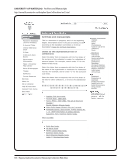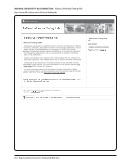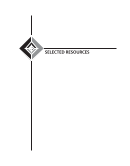70 · Survey Results: Survey Questions and Responses
granting agencies to continue to push EAD. In addition, a planned consortium tool is likely to be a driver for
expanded EAD implementation.”
“No internal some external.”
“No pressure.”
“No pressure at this point. We looked into EAD some years ago. We’re able to get the same access through other
means. We’ve exported MARC records into EAD for external union lists on the Web.”
“No. Library uses RAD (rules of archival descriptions).”
“Our professional staff and Catalog Department staff can not see any advantage in using EAD over standard
static HTML pages. We feel there are no justifications for increasing processing and description time and costs for
minimal advantage. Our manuscripts are linked by logic to the records of the institution. I believe that EAD is a
labor-intensive throwback to library cataloging methods of the past.”
“Self-imposed pressure to create EAD finding aids by virtue of participation in consortium, Northwest Digital
Archives.”
“Some internal, by people who do not understand the process or its requirements. In turn, they have received
external pressure.”
“The matter has been discussed, but no policy has been implemented.”
“The question is discussed from time to time, but so far there is a consensus (at least a weak consensus) that
the potential advantages of EAD encoding clearly warrant the substantial expense of markup. Until/unless that
balance clearly tips, I don’t think markup is likely. We are, however, discussing the possibility of moving item-/
folder-/series-level data to a database structure to allow us to separate the data from its delivery appearance.
The idea here is that we would put descriptive data in just one place, then create templates that would pull that
data into a delivery format (that might look like a finding aid, an index, etc.). Depending on the database field
structure, EAD might, in effect, be built in — or surpassed.”
“There is a subtle ‘keeping up with the Joneses’ kind of internal pressure to adapt whatever is cutting edge and
new as well as a substantive external and internal pressure to provide container lists with our current html finding
aids which could be accomplished with EAD or just straight html.”
“There is internal pressure to use EAD. That will continue to hold true for the immediate future.”
“We are looking at XML markup in TEI (P5) as an alternative for some collections, with EAD as an option for other
collections.”
“We may obtain a new database system, and we would like it to include EAD functions.”
“We will begin to use EAD this spring with the availability of the new OhioLINK EAD finding aid creation tool
(Web-based application).”
“Yes, the department head and library administration places a high priority on mounting our collection finding
aids on the Online Archive of California. We want more access and visibility for our collections.”
“Yes, we are required to at this time by a grant, but we have not begun the EAD portion yet. In addition, we feel
pressured by upper-level administration and the profession as a whole. Articles and conference presentations all
granting agencies to continue to push EAD. In addition, a planned consortium tool is likely to be a driver for
expanded EAD implementation.”
“No internal some external.”
“No pressure.”
“No pressure at this point. We looked into EAD some years ago. We’re able to get the same access through other
means. We’ve exported MARC records into EAD for external union lists on the Web.”
“No. Library uses RAD (rules of archival descriptions).”
“Our professional staff and Catalog Department staff can not see any advantage in using EAD over standard
static HTML pages. We feel there are no justifications for increasing processing and description time and costs for
minimal advantage. Our manuscripts are linked by logic to the records of the institution. I believe that EAD is a
labor-intensive throwback to library cataloging methods of the past.”
“Self-imposed pressure to create EAD finding aids by virtue of participation in consortium, Northwest Digital
Archives.”
“Some internal, by people who do not understand the process or its requirements. In turn, they have received
external pressure.”
“The matter has been discussed, but no policy has been implemented.”
“The question is discussed from time to time, but so far there is a consensus (at least a weak consensus) that
the potential advantages of EAD encoding clearly warrant the substantial expense of markup. Until/unless that
balance clearly tips, I don’t think markup is likely. We are, however, discussing the possibility of moving item-/
folder-/series-level data to a database structure to allow us to separate the data from its delivery appearance.
The idea here is that we would put descriptive data in just one place, then create templates that would pull that
data into a delivery format (that might look like a finding aid, an index, etc.). Depending on the database field
structure, EAD might, in effect, be built in — or surpassed.”
“There is a subtle ‘keeping up with the Joneses’ kind of internal pressure to adapt whatever is cutting edge and
new as well as a substantive external and internal pressure to provide container lists with our current html finding
aids which could be accomplished with EAD or just straight html.”
“There is internal pressure to use EAD. That will continue to hold true for the immediate future.”
“We are looking at XML markup in TEI (P5) as an alternative for some collections, with EAD as an option for other
collections.”
“We may obtain a new database system, and we would like it to include EAD functions.”
“We will begin to use EAD this spring with the availability of the new OhioLINK EAD finding aid creation tool
(Web-based application).”
“Yes, the department head and library administration places a high priority on mounting our collection finding
aids on the Online Archive of California. We want more access and visibility for our collections.”
“Yes, we are required to at this time by a grant, but we have not begun the EAD portion yet. In addition, we feel
pressured by upper-level administration and the profession as a whole. Articles and conference presentations all








































































































































































































